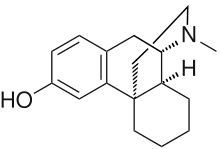dopamimetic
Bluelighter
- Joined
- Mar 21, 2013
- Messages
- 2,070
When looking at the molecules of especially ephenidine and that old opioid lefetamine (that's described as being comparable to codeine and having stimulant activity too), you'll notice something interesting (this can be extended to dextrorphan):



Now I guess from the graphics that lefetamine is only the L enantiomer while with the dissociatives we usually have both ones?
But nevertheless - has anyone ever confirmed that lefetamine is an opioid at all? Seems like they're just guessing. Do we have Another Weird Dissociative™ nobody really identified as one? Or are the L-diarylethylamines opioids while the D-ones are NMDA antagonists, like with the morphinans?
It doesn't confirm direct opioid activity if something kills pain, relieves opioid withdrawal or is reversible by naloxone really - look at dextromethorphan. Does lefetamine induce opioid-like withdrawal when used for longer times?
Other question, is anything known about the other binding affinities of the diarylethylamines, over what mechanisms do the exhibit their stimulatory activity? The NMDA antagonism seems to be confirmed, but this might be the only property that's for sure? Maybe they are in fact quite selective NMDA antagonists that lack the HCN1 activity of e.g. Ketamine?
Lefetamine: new abuse of an old drug - clinical evaluation of opioid activity
Toxicokinetics of lefetamine and derived diphenylethylamine designer drugs – Contribution of human cytochrome P450 isozymes to their main phase I metabolic steps



Now I guess from the graphics that lefetamine is only the L enantiomer while with the dissociatives we usually have both ones?
But nevertheless - has anyone ever confirmed that lefetamine is an opioid at all? Seems like they're just guessing. Do we have Another Weird Dissociative™ nobody really identified as one? Or are the L-diarylethylamines opioids while the D-ones are NMDA antagonists, like with the morphinans?
Lefetamine (SPA) combining amphetamine with opioid-like effects, a drug of wide abuse in Japan in the fifties, has now been introduced as such in Italy. In this study the drug was tested to verify its resemblance to opiates. Ten lefetamine abusers were hospitalized and then subjected to naloxone- and pentazocine-tests and detoxified. Moreover, lefetamine was adminis- tered to ten opiate addicts with an acute withdrawal syndrome and to ten methadone-treated addicts. The naloxone-test was positive and pentazocine could be substituted for lefetamine. Lefetamine was able to relieve opiate withdrawal and did not precipitate withdrawal symptoms in stabilized opiate addicts. It is concluded that lefetamine may act as an opioid partial agonist.
It doesn't confirm direct opioid activity if something kills pain, relieves opioid withdrawal or is reversible by naloxone really - look at dextromethorphan. Does lefetamine induce opioid-like withdrawal when used for longer times?
Other question, is anything known about the other binding affinities of the diarylethylamines, over what mechanisms do the exhibit their stimulatory activity? The NMDA antagonism seems to be confirmed, but this might be the only property that's for sure? Maybe they are in fact quite selective NMDA antagonists that lack the HCN1 activity of e.g. Ketamine?
Lefetamine: new abuse of an old drug - clinical evaluation of opioid activity
Toxicokinetics of lefetamine and derived diphenylethylamine designer drugs – Contribution of human cytochrome P450 isozymes to their main phase I metabolic steps
Last edited:
